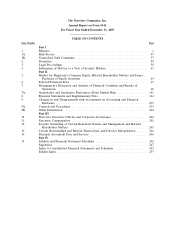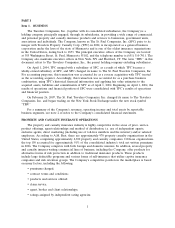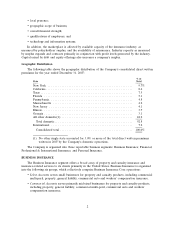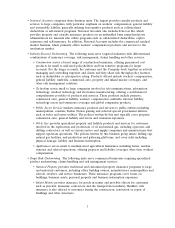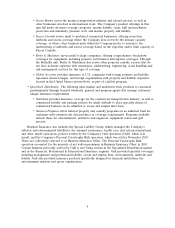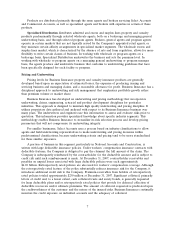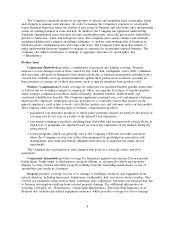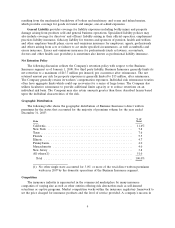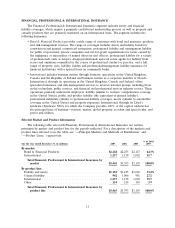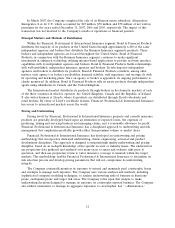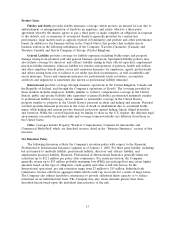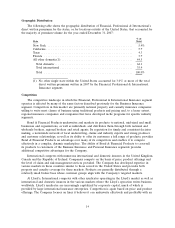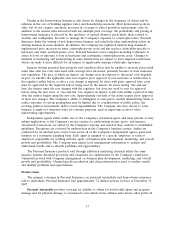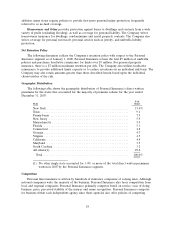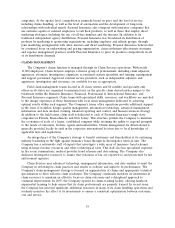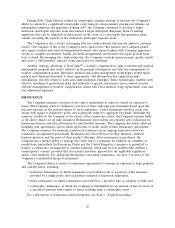Travelers 2007 Annual Report Download - page 22
Download and view the complete annual report
Please find page 22 of the 2007 Travelers annual report below. You can navigate through the pages in the report by either clicking on the pages listed below, or by using the keyword search tool below to find specific information within the annual report.the competitive commercial insurance landscape is largely measured by its ability to provide insurance
and services at a price that is reasonable and acceptable to the customer, as well as its ability to retain
existing customers and to attract new customers.
Select Accounts business is typically written through independent agents and, to a lesser extent,
regional brokers and direct writers. Both national and regional property casualty insurance companies
compete in the Select Accounts market which generally comprises lower hazard, ‘‘main street’’ business
customers. Risks are underwritten and priced using standard industry practices and a combination of
proprietary and standard industry product offerings. Competition in this market is primarily based on
product offerings, service levels, ease of doing business and price. Select Accounts has established a
strong marketing relationship with its distribution network and has provided it with defined
underwriting policies, a broad array of products, competitive prices and one of the most efficient
automated environments in the industry. In addition, the Company has established centralized service
centers to help agents perform many service functions, in return for a fee.
Commercial Accounts business has historically been written through independent agents and
brokers, although some companies use direct writing. Competitors in this market are primarily national
property casualty insurance companies willing to write most classes of business using traditional
products and pricing, and regional insurance companies. Companies compete based on product
offerings, service levels, price and claim and loss prevention services. Improved efficiency through
automation and shortened response time to customer needs is key to success in this market.
The National Accounts group is comprised of three business units:
• National Accounts business is typically written through national brokers and, to a lesser extent,
regional brokers. Insurance companies compete in this market based on price, product offerings,
claim and loss prevention services, managed care cost containment and risk management
information systems. National Accounts also offers a large nationwide network of localized claim
service centers which provide greater flexibility in claims adjusting and allows National Accounts
to more quickly respond to the needs of its customers.
• Discover Re competes with traditional providers of commercial insurance coverages, as well as
other underwriters of property and casualty insurance in the alternative risk transfer market,
such as risk retention groups, self-insurance plans, captives managed by others, and a variety of
other risk-financing vehicles and mechanisms.
• National Accounts’ residual market business competes for state contracts to provide claims and
policy management services. These contracts, which generally have three-year terms, are selected
by state agencies through a bid process based on the quality of service and price. National
Accounts services approximately 36% of the total workers’ compensation assigned risk market,
making the Company one of the largest servicing carriers in the industry.
There are several other business groups in Business Insurance that compete in focused target
markets. Each of these markets is different and requires unique combinations of industry knowledge,
proprietary coverage forms, specialized risk control and loss handling services, and partnerships with
agents and brokers that also focus on these markets. Some of these business groups compete with
national carriers with similarly dedicated underwriting and marketing groups, whereas others compete
with smaller regional companies. In either case, these businesses have regional structures that allow
them to deliver personalized service and local knowledge to their customer base. Specialized agents and
brokers, including managing general agents and wholesale agents, supplement this strategy. In all of
these businesses, the competitive strategy is market leadership attained through focused industry
knowledge applied to insurance and risk needs.
10


